Wietse
Well-Known Member
Hey guys,
The other day i had removed the oil pan for the first time since i own the car.
I had some rattling noise and was unable to locate it initially, so i had dropped the oil and thought it's wise to have a look in the pan to see if there is something wrong inside.
The rattling noise source was found later on, cracked header tube on cylinder #3.
Anyway, in the pan nothing unusual found other then some marks where the oil pickup had been hitting the pan due to a dent which i straightened up before putting it back.
Also cleaned the pan out from quite some accumulated sludge.
When removing i bend the windage tray so i did not put it back, bad thing?
I only know the engine supposed to be rebuild by a PO but when and what was done i don't know.
My main question is, looking at the bottom of the pistons if someone could identify them by something? (brand/type?)
Looks like there has been some machining done on the bottom for reasons unknown, guess a clearance issue?
Think the crank and rods are oem components, but pistons seem aftermarket right?
Also the converter is something i have no idea about, same for the rocker arms.
By a rough measurement it seems the rocker arms are 1.6 ratio.
I did not find any part numbers on converter and rocker arms so i have nothing to revert to.
Maybe some of you guys run same components which you could tell me something about?
The thing with the engine is, it runs well and has power, has good compression on all cylinders (200 psi), does not use much oil so there is no need for a full rebuild.
It has 10Hg vacuum at best @ 900 rpm, idle has always been with a stumble on any timing/carb setting.
The camshaft, of which i have no specs from, seems to be quite setup for racing.
I don't see an immediate reason for replacing it, but do wonder what would happen if i replace the assuming 1.6 ratio rocker arms for 1.5 ratio?
Does this tame the engine a bit as it reduces valve lift? basically would that improve vacuum and idle quality?
I also understand when replacing the camshaft for one with a different profile i would need to replace the converter with one that meets the camshaft profile right?
I believe converter stall speed should be a little higher then the lowest reading of the camshaft rpm band.
What size converter is used on the 440 HP engines? 11"?
I am going to pull the engine out anyway because i want to clean up the engine bay and get a paint job done in there.
And i will need new headers, change the engine mounts, do some repairs on the threaded holes for the exhaust header and give the engine a clean and new coat of Hemi orange.
If the engine is out it is the obvious right time to change camshaft and converter if i have to.
My idea was i could check the camshaft specs with a crank degree wheel and a clock gauge right? (Check degree's at 0.050" lift right?)
I want a street/strip type engine, i don't race it on the track.
I am fed up of the poor vacuum and rough idle.
The car is a '69 Coronet R/T with auto tranny. 4.10 ratio rear axle with limited slip diff (plan to change to 3.23 gears), Power brakes, power steering.
I know it's a far shot but any info i could get would help me out.
Your help would be highly appreciated!
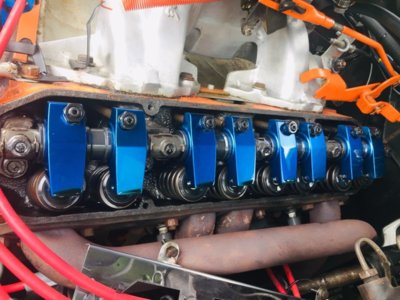
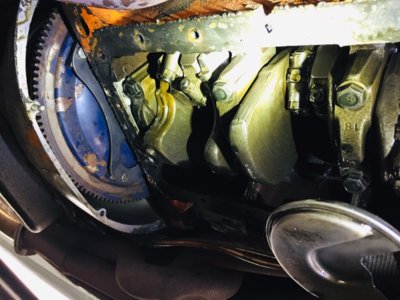
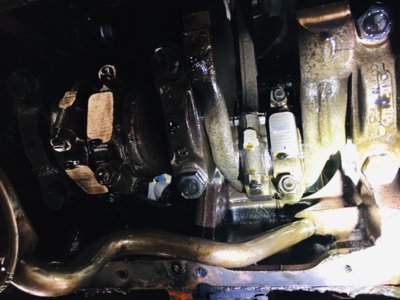
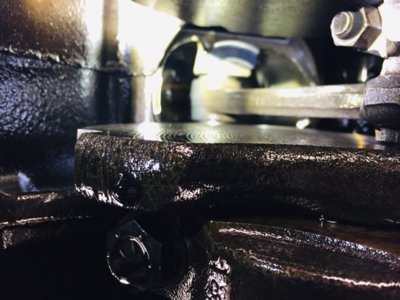
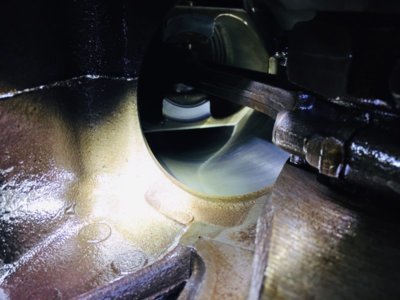
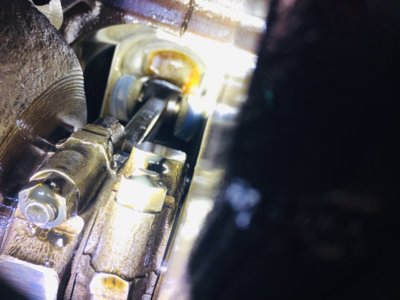
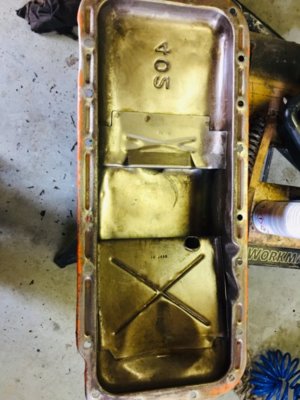
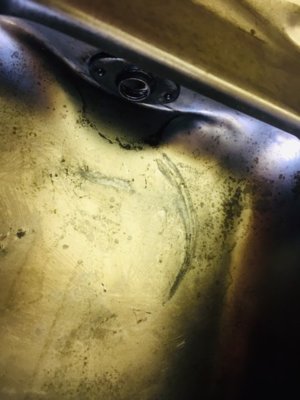
The other day i had removed the oil pan for the first time since i own the car.
I had some rattling noise and was unable to locate it initially, so i had dropped the oil and thought it's wise to have a look in the pan to see if there is something wrong inside.
The rattling noise source was found later on, cracked header tube on cylinder #3.
Anyway, in the pan nothing unusual found other then some marks where the oil pickup had been hitting the pan due to a dent which i straightened up before putting it back.
Also cleaned the pan out from quite some accumulated sludge.
When removing i bend the windage tray so i did not put it back, bad thing?
I only know the engine supposed to be rebuild by a PO but when and what was done i don't know.
My main question is, looking at the bottom of the pistons if someone could identify them by something? (brand/type?)
Looks like there has been some machining done on the bottom for reasons unknown, guess a clearance issue?
Think the crank and rods are oem components, but pistons seem aftermarket right?
Also the converter is something i have no idea about, same for the rocker arms.
By a rough measurement it seems the rocker arms are 1.6 ratio.
I did not find any part numbers on converter and rocker arms so i have nothing to revert to.
Maybe some of you guys run same components which you could tell me something about?
The thing with the engine is, it runs well and has power, has good compression on all cylinders (200 psi), does not use much oil so there is no need for a full rebuild.
It has 10Hg vacuum at best @ 900 rpm, idle has always been with a stumble on any timing/carb setting.
The camshaft, of which i have no specs from, seems to be quite setup for racing.
I don't see an immediate reason for replacing it, but do wonder what would happen if i replace the assuming 1.6 ratio rocker arms for 1.5 ratio?
Does this tame the engine a bit as it reduces valve lift? basically would that improve vacuum and idle quality?
I also understand when replacing the camshaft for one with a different profile i would need to replace the converter with one that meets the camshaft profile right?
I believe converter stall speed should be a little higher then the lowest reading of the camshaft rpm band.
What size converter is used on the 440 HP engines? 11"?
I am going to pull the engine out anyway because i want to clean up the engine bay and get a paint job done in there.
And i will need new headers, change the engine mounts, do some repairs on the threaded holes for the exhaust header and give the engine a clean and new coat of Hemi orange.
If the engine is out it is the obvious right time to change camshaft and converter if i have to.
My idea was i could check the camshaft specs with a crank degree wheel and a clock gauge right? (Check degree's at 0.050" lift right?)
I want a street/strip type engine, i don't race it on the track.
I am fed up of the poor vacuum and rough idle.
The car is a '69 Coronet R/T with auto tranny. 4.10 ratio rear axle with limited slip diff (plan to change to 3.23 gears), Power brakes, power steering.
I know it's a far shot but any info i could get would help me out.
Your help would be highly appreciated!
























